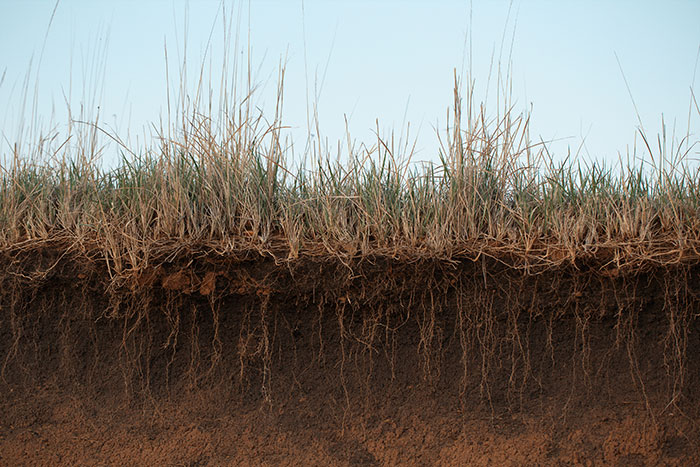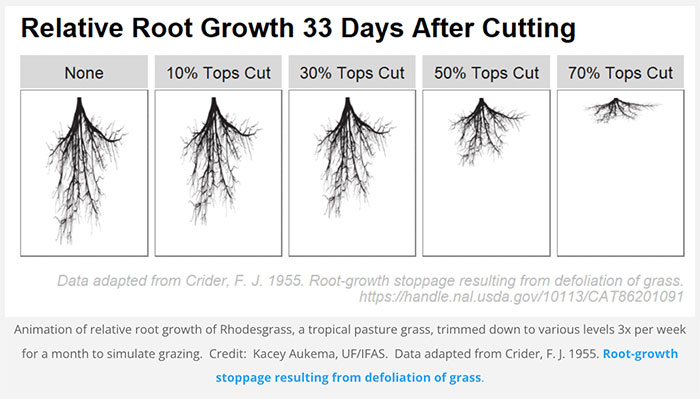
The productivity of a perennial grass pasture is quite literally anchored in its root system. Roots are responsible for water and nutrient uptake, transporting these materials to other plant parts, and supporting aboveground biomass. Roots are also the home base for symbiotic relationships between plants and microorganisms, and they serve as a storage structure for energy produced during photosynthesis.
While strong roots foster resilient stands, a feeble foundation can compromise grass growth on the surface. For example, shallow roots have a reduced capacity for water and nutrient uptake. Furthermore, forage regrowth after cutting hay or grazing livestock may be delayed if root systems are weak.
Root growth and vegetative growth occur independent of one another; however, each type of growth is critical for its counterpart. In a recent Panhandle Ag e-News newsletter, Kacey Aukema with University of Florida Extension explains that when grass species are cut or grazed, defoliated plants rely on energy stored in their roots to fuel new growth. As nutrients are mobilized from root to shoot, plants prioritize vegetative growth. Then as new leaves develop and begin to photosynthesize, energy is redirected belowground and root growth commences again.
Aukema, an agricultural extension agent in Walton County, Fla., notes some perennial warm-season grass species like bermudagrass and bahiagrass that are widely grown in the Sunshine State store energy in underground modified stems called rhizomes. Like root reserves, rhizome reserves are depleted when forage is defoliated.
Although the speed of vegetative growth and root growth depends on several factors like water availability, fertilization, and weather conditions, Aukema suggests two of the most important factors are the intensity and frequency at which grass is cut or grazed. When too much of a plant is removed and/or forages do not have enough time to accumulate and store energy in their roots between harvests, root growth will slow down and possibly stop. This ultimately impairs the condition of a grass forage stand.
Running on empty
Aukema compares root reserves to the gas tank in a car. Regardless of fuel efficiency or tank size, a vehicle will eventually run out of gas if the driver never stops to fill up. Likewise, plants will suffer if they don’t have the chance to replenish their root reserves.
To continue the analogy, drivers with shorter commutes will have more miles until empty at the end of the workday. The same goes for root reserves in that they will have more energy available for growth when less aboveground biomass is removed. This concept was demonstrated in a research study by Franklin Crider, a scientist with the USDA Soil Conservation Service, in the 1950s.
Crider observed how clipping rhodesgrass at various heights affected root growth. In the study, the warm-season perennial grass was clipped three times a week for a month to simulate grazing livestock. Overall, the lower the clipping height, the weaker the root system.
“When more than 70% of the tops were cut, the roots stopped growing altogether,” Aukema explains. “When 50% of the tops were removed, the root growth slowed down from levels before the start of the cutting but did not stop. When less than 40% of the tops were trimmed, root growth did not slow down compared to before cutting.”

Slowed or ceased root growth is especially detrimental during drought when water is located deeper in the soil profile. These shallow root systems can also curtail nutrient uptake, which can lead to more nitrate leaching and lower fertilization efficiency.
Refilling the tank
Raising the cut height or moving cattle before they overgraze can help restore root reserves. Giving plants a longer rest period between harvests may also improve root growth and function. To demonstrate this, Crider conducted another study on rhodesgrass, but this time, forage was only clipped once during the month-long trial.
Root growth still stopped when forage was clipped to the lowest levels; however, it eventually resumed as forage had more time to recover. Although Crider’s experiments were conducted in a controlled setting and not a field environment, Aukema believes the findings promote key principles of pasture management. “Continuous grazing or cutting of pasture forages too short and without rest will stop roots from growing and likely eventually lead to decline of that pasture,” he asserts.
Ease up on harvest intensity and frequency if perennial grass pastures run out of gas. Aukema recommends administering split applications of fertilizer to boost pasture recovery in overgrazed stands while limiting nutrient losses from leaching. Controlling weeds and preventing competition with unwanted species will help forage grow stronger above and below the surface, too.

